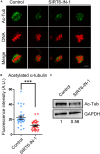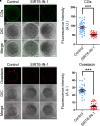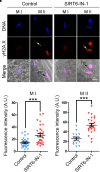SIRT6 Maintains Redox Homeostasis to Promote Porcine Oocyte Maturation
- PMID: 33718364
- PMCID: PMC7947247
- DOI: 10.3389/fcell.2021.625540
SIRT6 Maintains Redox Homeostasis to Promote Porcine Oocyte Maturation
Abstract
SIRT6, the sixth member of the sirtuin family proteins, has been characterized as a crucial regulator in multiple molecular pathways related to aging, including genome stability, DNA damage repair, telomere maintenance, and inflammation. However, the exact roles of SIRT6 during female germ cell development have not yet been fully determined. Here, we assessed the acquisition of meiotic competency of porcine oocytes by inhibition of SIRT6 activity. We observed that SIRT6 inhibition led to the oocyte meiotic defects by showing the impairment of polar body extrusion and cumulus cell expansion. Meanwhile, the compromised spindle/chromosome structure and actin dynamics were also present in SIRT6-inhibited oocytes. Moreover, SIRT6 inhibition resulted in the defective cytoplasmic maturation by displaying the disturbed distribution dynamics of cortical granules and their content ovastacin. Notably, we identified that transcript levels of genes related to oocyte meiosis, oxidative phosphorylation, and cellular senescence were remarkably altered in SIRT6-inhibited oocytes by transcriptome analysis and validated that the meiotic defects caused by SIRT6 inhibition might result from the excessive reactive oxygen species (ROS)-induced early apoptosis in oocytes. Taken together, our findings demonstrate that SIRT6 promotes the porcine oocyte meiotic maturation through maintaining the redox homeostasis.
Keywords: SIRT6; apoptosis; meiotic failure; oocyte maturation; redox homeostasis.
Copyright © 2021 Li, Miao, Chen and Xiong.
Conflict of interest statement
The authors declare that the research was conducted in the absence of any commercial or financial relationships that could be construed as a potential conflict of interest.
Figures









Similar articles
-
Cumulus cell-derived and maternal SIRT6 differentially regulates porcine oocyte meiotic maturation.Theriogenology. 2020 Jan 15;142:158-168. doi: 10.1016/j.theriogenology.2019.09.048. Epub 2019 Sep 28. Theriogenology. 2020. PMID: 31593883
-
Dynein promotes porcine oocyte meiotic progression by maintaining cytoskeletal structures and cortical granule arrangement.Cell Cycle. 2017;16(21):2139-2145. doi: 10.1080/15384101.2017.1380133. Epub 2017 Oct 4. Cell Cycle. 2017. PMID: 28933593 Free PMC article.
-
Eg5 orchestrates porcine oocyte maturational progression by maintaining meiotic organelle arrangement.Cell Div. 2018 May 24;13:4. doi: 10.1186/s13008-018-0037-1. eCollection 2018. Cell Div. 2018. PMID: 29796058 Free PMC article.
-
Oocyte maturation: gamete-somatic cells interactions, meiotic resumption, cytoskeletal dynamics and cytoplasmic reorganization.Hum Reprod Update. 2015 Jul-Aug;21(4):427-54. doi: 10.1093/humupd/dmv011. Epub 2015 Mar 4. Hum Reprod Update. 2015. PMID: 25744083 Review.
-
The Role and Molecular Pathways of SIRT6 in Senescence and Age-related Diseases.Adv Biol (Weinh). 2025 Apr;9(4):e2400469. doi: 10.1002/adbi.202400469. Epub 2025 Feb 6. Adv Biol (Weinh). 2025. PMID: 39913122 Review.
Cited by
-
Identification of genes related to sexual differentiation and sterility in embryonic gonads of Mule ducks by transcriptome analysis.Front Genet. 2022 Oct 26;13:1037810. doi: 10.3389/fgene.2022.1037810. eCollection 2022. Front Genet. 2022. PMID: 36386800 Free PMC article.
-
Nicotinamide mononucleotide biosynthesis and the F-actin cytoskeleton regulate spindle assembly and oocyte maturation quality in post-ovulatory aged porcine oocytes.Cell Commun Signal. 2025 Apr 17;23(1):186. doi: 10.1186/s12964-025-02200-4. Cell Commun Signal. 2025. PMID: 40247324 Free PMC article.
-
Ovarian aging: energy metabolism of oocytes.J Ovarian Res. 2024 May 31;17(1):118. doi: 10.1186/s13048-024-01427-y. J Ovarian Res. 2024. PMID: 38822408 Free PMC article. Review.
-
Supplementation of SDF1 during Pig Oocyte In Vitro Maturation Improves Subsequent Embryo Development.Molecules. 2022 Oct 12;27(20):6830. doi: 10.3390/molecules27206830. Molecules. 2022. PMID: 36296422 Free PMC article.
-
Aberrant Expression of Mitochondrial SAM Transporter SLC25A26 Impairs Oocyte Maturation and Early Development in Mice.Oxid Med Cell Longev. 2022 Apr 13;2022:1681623. doi: 10.1155/2022/1681623. eCollection 2022. Oxid Med Cell Longev. 2022. PMID: 35464759 Free PMC article.
References
LinkOut - more resources
Full Text Sources
Other Literature Sources
Molecular Biology Databases

